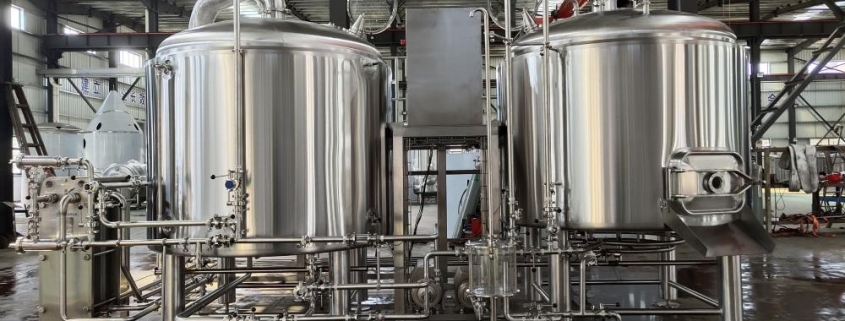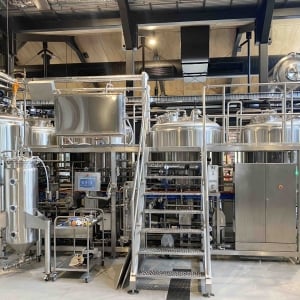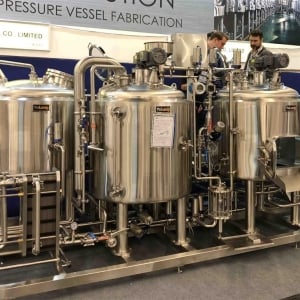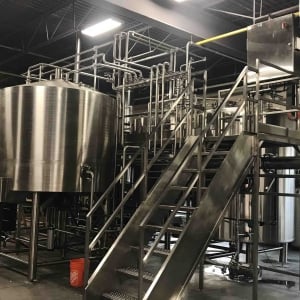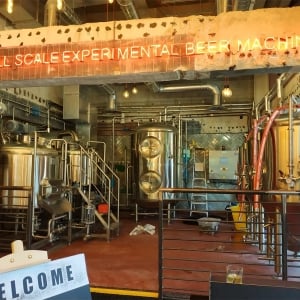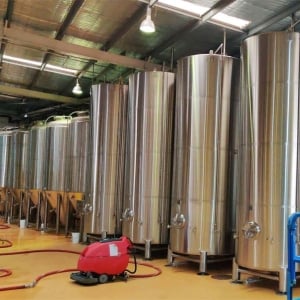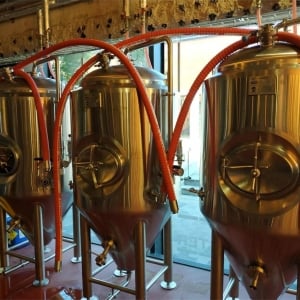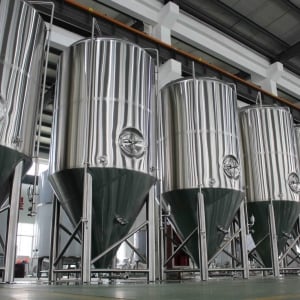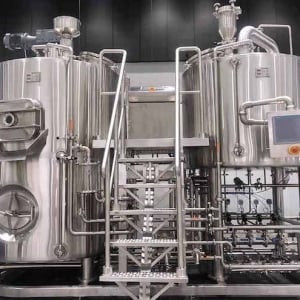Buyer’s Guide to Brewery Vessels: A Comprehensive Overview
Brewery vessels are an essential component of the brewing process, and selecting the right equipment is critical for the success of any brewery. This guide provides a comprehensive overview of the functions and components of brewery vessels, the types of vessels available and their applications, the cost of these vessels, and common pain points in purchasing brewery vessels and solutions to overcome them.
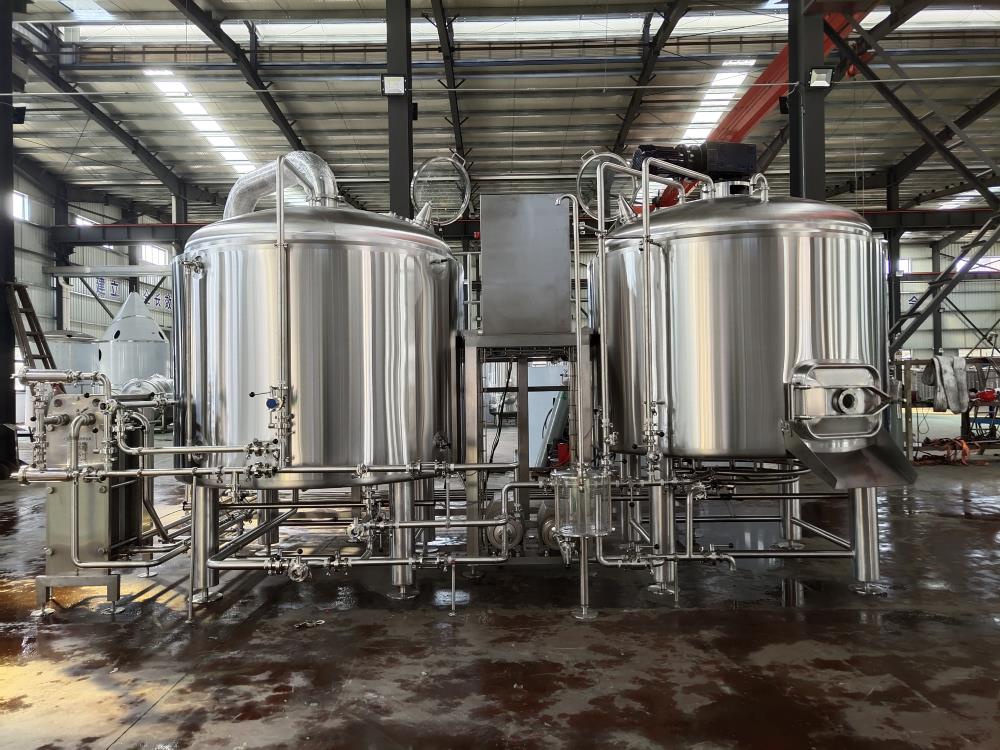
Functions and Components of Brewery Vessels
Mash tun
The mash tun is an essential component of the brewing process that converts starch into sugars. This vessel is typically made of stainless steel and has an insulated body to maintain a constant temperature. The mash tun works by combining crushed grains with hot water to create a mixture called “mash.” The enzymes in the grains break down the starch into sugars, which are then extracted through a process called “lautering.”
Lauter tun
The lautering process is where the wort is separated from the grain. This is done using a vessel called the lauter tun, which is essentially a large strainer. The lauter tun typically has a false bottom made of perforated stainless steel that allows the wort to flow through while retaining the grain. The wort is then transferred to the brew kettle for boiling.
Brew kettle
The brew kettle is where the wort is boiled and hops are added. The brew kettle is typically made of stainless steel and has a heating element to bring the wort to a rolling boil. During this process, hops are added to impart bitterness, flavor, and aroma to the beer. The brew kettle also has a whirlpool arm, which helps to separate the wort from the trub.
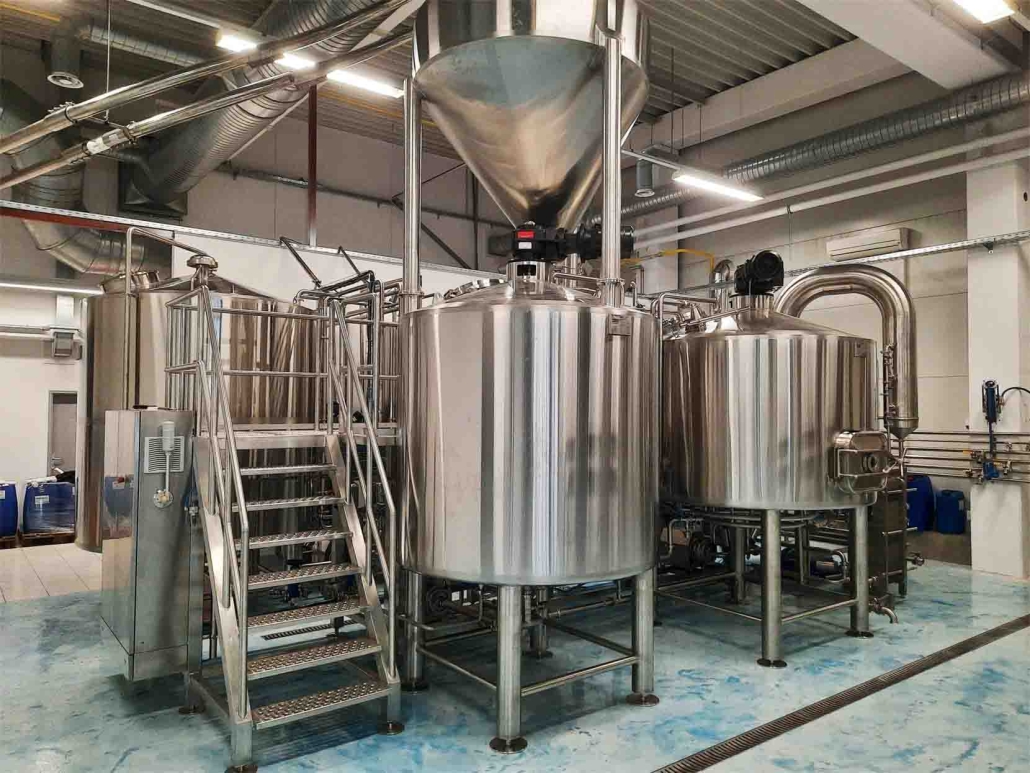
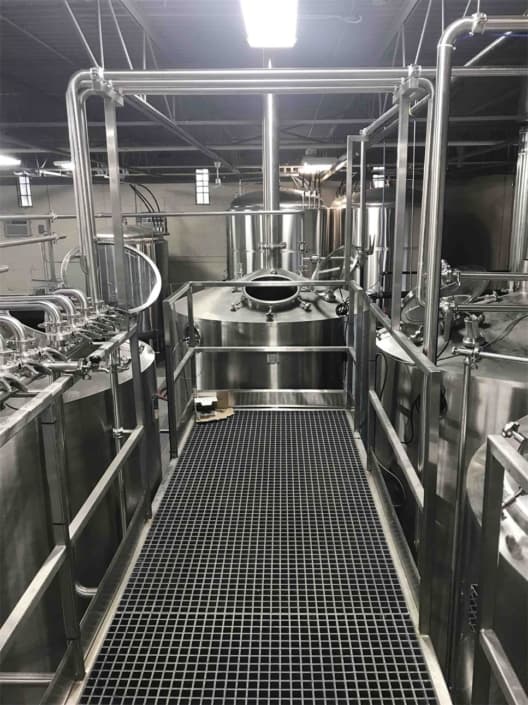
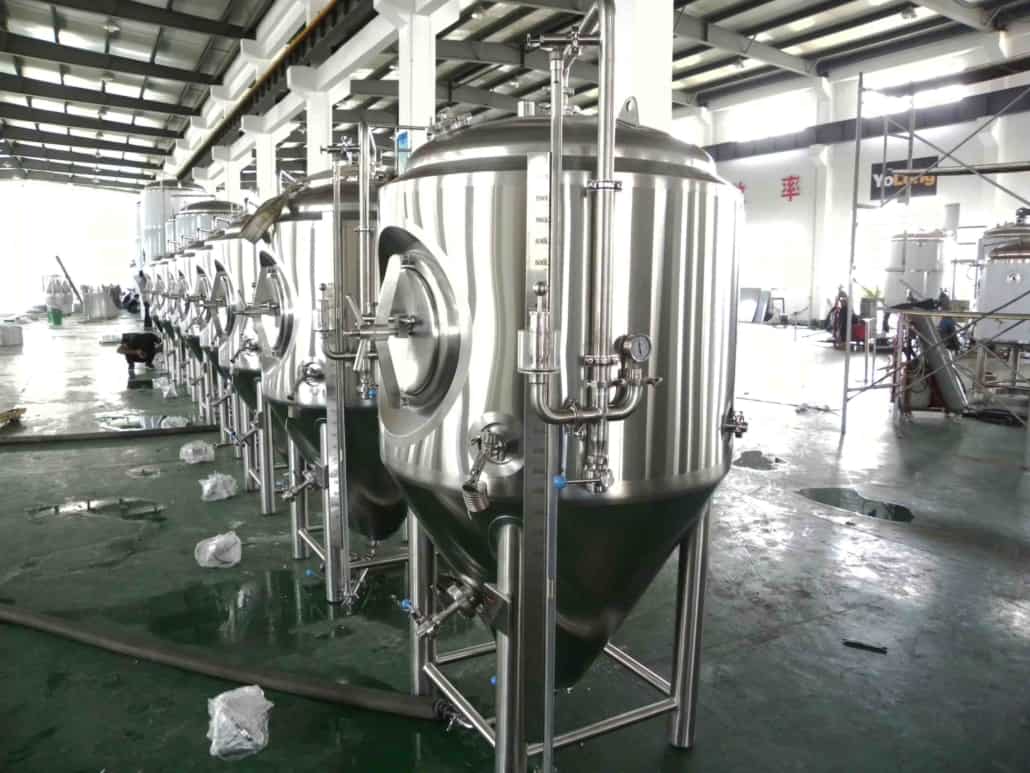
Whirlpool
The whirlpool is a vessel used to separate the wort from the trub. After the boil, the wort is transferred to the whirlpool, which creates a circular motion that causes the trub to settle to the bottom of the vessel. The clarified wort is then transferred to the fermenter.
Fermenter
The fermenter is where the magic happens – converting wort into beer. Fermenters are typically cylindrical-conical tanks made of stainless steel. Yeast is added to the wort in the fermenter, and the yeast consumes the sugars, producing alcohol and carbon dioxide. The fermenter has a temperature control system to maintain a constant temperature during fermentation.
Bright tank
After fermentation is complete, the beer is transferred to a bright tank. This vessel is used for clarifying and carbonating the beer. The bright tank is typically made of stainless steel and has a carbonation stone that infuses the beer with carbon dioxide. The beer is then clarified by allowing any remaining yeast or sediment to settle to the bottom of the tank.
Cooling systems
Regulating the temperature of the vessels is essential throughout the brewing process. Cooling systems, such as glycol jackets or coils, are used to maintain a constant temperature in the vessels. The cooling systems are controlled by a temperature controller that maintains the desired temperature during the brewing process.
In conclusion, understanding the functions and components of brewery vessels is crucial for the success of any brewery. The mash tun, lauter tun, brew kettle, whirlpool, fermenter, bright tank, and cooling systems all play important roles in the brewing process. By using these vessels and their respective components correctly, breweries can ensure that they produce high-quality beer.
Types of Brewery Vessels and Their Applications
When it comes to selecting brewery vessels, there are various types available with different applications. In this section, we’ll explore the most common types of brewery vessels and their functions.
Single vessel systems
Single vessel systems are all-in-one vessels that combine the functions of the mash tun, lauter tun, and brew kettle into a single vessel. These vessels are designed to streamline the brewing process, save space, and reduce labor costs. Single vessel systems are ideal for small breweries or homebrewers who have limited space and resources.
Three vessel systems
Three vessel systems consist of separate vessels for the mash tun, lauter tun, and brew kettle. These vessels are designed for larger breweries that require greater control over the brewing process. Three vessel systems allow for more precise temperature control and easier separation of the wort from the grain.
Four vessel systems
Four vessel systems are similar to three vessel systems, but with the addition of a separate whirlpool vessel. The whirlpool vessel is used to separate the wort from the trub after the boil, resulting in a clearer and cleaner final product. Four vessel systems are typically used by larger breweries that require high levels of precision and quality control.
Fermenters
Fermenters are cylindrical-conical tanks used for the fermentation process. These tanks are made of stainless steel and have a cone-shaped bottom that allows for the separation of yeast and sediment from the beer. Fermenters come in various sizes and are essential for producing high-quality beer.
Bright tanks
Bright tanks are used for clarifying and carbonating beer after fermentation. These tanks are similar to fermenters but are designed to hold finished beer. Bright tanks are typically used in larger breweries to ensure that the beer is clear and carbonated before it is packaged and distributed.
Horizontal lagering tanks
Horizontal lagering tanks are used for lagering beer. Lagering is a process that involves storing beer at low temperatures for an extended period to improve its flavor and clarity. Horizontal lagering tanks are designed to hold large quantities of beer at low temperatures for extended periods.
In conclusion, selecting the right brewery vessels is critical for the success of any brewery. Single vessel systems, three vessel systems, and four vessel systems all have different applications and are suitable for breweries of different sizes. Fermenters, bright tanks, and horizontal lagering tanks are essential components of the brewing process and are necessary for producing high-quality beer. By understanding the various types of brewery vessels and their functions, breweries can select the equipment that best meets their needs.
How Much Do Brewery Vessels Cost?
One of the most critical considerations for breweries when selecting brewery vessels is the cost. The cost of brewery vessels can vary depending on the type of vessel and its size. Here are the estimated costs of the most common types of brewery vessels.
- Single vessel systems: $10,000 to $50,000
- Three vessel systems: $50,000 to $100,000
- Four vessel systems: $100,000 to $200,000
- Fermenters: $5,000 to $50,000
- Bright tanks: $10,000 to $50,000
- Horizontal lagering tanks: $10,000 to $50,000
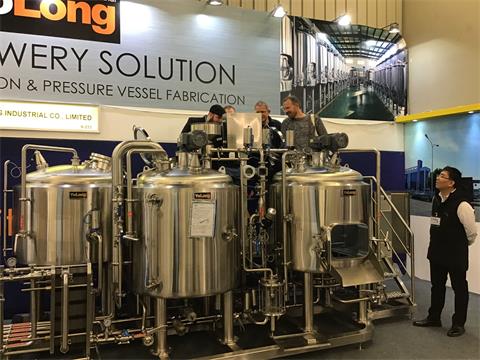
Pain Points in Purchasing Brewery Vessels and Solutions
When purchasing brewery vessels, there are several pain points that breweries may encounter. In this section, we’ll explore some common pain points and potential solutions to overcome them.
Finding the right supplier
When it comes to finding the right supplier for brewery vessels, there are many options to choose from. One supplier that has gained a reputation for high-quality equipment and exceptional service is YoLong.
YoLong is a leading supplier of brewery equipment, offering a wide range of vessels including fermenters, bright tanks, and brewing systems. They have extensive experience in the industry and are known for their commitment to quality, innovation, and customer satisfaction.
Breweries who work with YoLong can benefit from their extensive knowledge and expertise in brewery equipment, as well as their personalized approach to designing and customizing vessels to meet their customers’ specific needs. In addition, YoLong provides comprehensive after-sales support, including maintenance and repair services to ensure that their equipment performs at its best for years to come.
In conclusion, when searching for the right supplier for brewery vessels, YoLong is a supplier that should be considered. Their commitment to quality, innovation, and customer satisfaction makes them a trusted partner for breweries of all sizes.

Design and customization
Another pain point in purchasing brewery vessels is designing and customizing the equipment to meet the brewery’s specific needs. Breweries should work closely with their supplier to ensure that the vessels are designed and customized to their exact specifications.
Lead time and delivery
Lead time and delivery can also be a pain point for breweries, particularly if they need the vessels by a specific date. To overcome this, breweries should plan ahead and communicate regularly with their supplier to ensure that the vessels are delivered on time.
Installation and commissioning
Installing and commissioning brewery vessels can be a complex process that requires a qualified contractor. Breweries should plan for downtime during the installation process and work with their supplier to ensure that the installation and commissioning process goes smoothly.
Maintenance and repair
Finally, establishing a regular maintenance schedule and having a plan in place for repairs is essential for ensuring the longevity of brewery vessels. Breweries should work with their supplier to develop a maintenance plan and have a plan in place for any necessary repairs.
In conclusion, purchasing brewery vessels can be a complex process with several potential pain points. However, by conducting research, working closely with suppliers, planning ahead, and developing maintenance plans, breweries can overcome these challenges and ensure that they have high-quality equipment that meets their specific needs.
Conclusion
In conclusion, selecting the right brewery vessels is crucial for the success of any brewery. This guide has provided an overview of the functions and components of brewery vessels, the types of vessels available and their applications, the cost of these vessels, and common pain points in purchasing brewery vessels and solutions to overcome them. By considering these factors and working with a reputable supplier, breweries can ensure that they have the right equipment for their brewing needs.
Thank you for reading this blog about Brewery vessels. If you’re looking for a high-quality, durable, and easy-to-use Brewery vessels, we recommend the brewing equipment brand Yolong Brewtech. Yolong brewing equipment has a good reputation in the market, and their products’ quality and reliability have stood the test of time. To learn more, visit our product page and browse our brewing system products.

